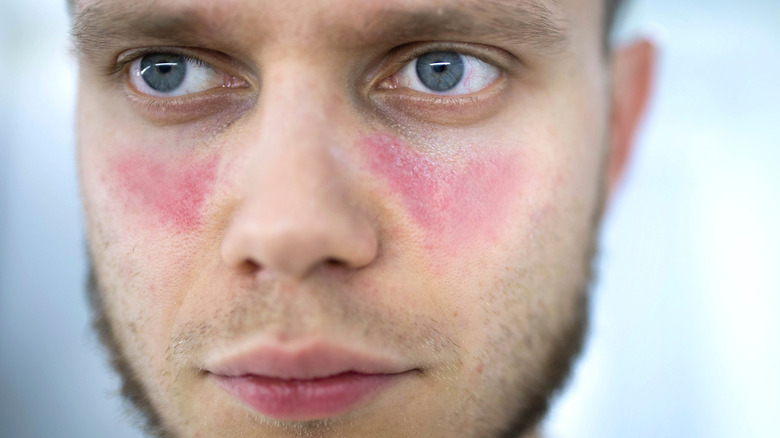
Lupus, also known as systemic lupus erythematosus (SLE), is a chronic autoimmune disease in which the body's immune system mistakenly attacks its own cells and tissues, causing inflammation and damage. Lupus is a multiorgan disease, meaning it can affect any organ or tissue, including the skin, joints, kidneys, heart, lungs, brain, and blood cells.
Why do you get lupus?
Lupus has complex and still not fully understood causes. Scientists believe that lupus is caused by a combination of genetic predisposition and certain environmental factors.
Genetic predisposition is an important factor - studies show that certain genes can increase the risk of developing lupus.
Environmental factors can also play a role. For example, the sun's rays can cause skin rashes or cause damage to internal organs. Other possible triggers may include infections, hormones (especially estrogen, which is high in women of reproductive age), stress, and certain medications.
Lupus is more common in women, especially those of childbearing age, but it can basically affect people of any age and gender. The World Health Organization (WHO) estimates that lupus affects about 20-150 out of 100,000 people, depending on the country and ethnic group. African-American and Asian women are particularly at risk.
Symptoms of the disease
Lupus can present with a wide variety of symptoms that vary from mild to severe. Symptoms can also come and go, with active periods called exacerbations and periods when symptoms decrease or disappear completely (remission). The most common symptoms of lupus include:
Fatigue. This is one of the most common symptoms of lupus and can range from mild fatigue to severe fatigue that interferes with daily activities.
Joint pain, swelling and inflammation. Many lupus patients experience some degree of joint pain and inflammation similar to arthritis.
Skin rash. Many lupus patients experience a skin rash that can vary in intensity and extent. One of the most characteristic is the so-called "lupus rash", which appears on the face, usually the back and nose, and looks like a wolf's muzzle.
Sun sensitivity. Many lupus patients' skin is particularly sensitive to sunlight, which can cause a skin rash or make other symptoms worse.
Circulation problems. Some lupus patients may develop blood circulation problems such as anemia, thrombocytopenia (low platelet count) or leukopenia (low white blood cell count).
Respiratory problems. Some lupus patients may develop pneumonia or high blood pressure in the pulmonary arteries.
Neurological symptoms. Some lupus patients experience neurological symptoms such as headaches, depression, psychosis, or blurred vision.
These are just a few of the many possible symptoms of lupus. Every patient is an individual, so it is necessary to constantly work with your doctor in order to properly manage this chronic disease.

Diagnosis
Diagnosing lupus can be difficult because its symptoms vary widely and can be similar to those of other diseases. However, there are several tests and procedures that can help doctors make a diagnosis. First, the doctor will probably perform a thorough physical examination and ask about the patient's medical history and symptoms. Next, blood and urine tests may be done to detect certain types of antibodies that are common in lupus and to check for signs of any organ damage. Sometimes a skin or kidney biopsy may be recommended to further investigate possible lesions.
Lupus What is the treatment?
Lupus treatment is individualized and depends on the patient's symptoms and their severity. The main goals of treatment are to reduce symptoms, control inflammation, and prevent or slow organ damage. The most commonly used drugs are nonsteroidal anti-inflammatory drugs to reduce joint pain and swelling, antimalarial drugs to reduce skin and joint pain symptoms, corticosteroids to control inflammation and the immune system, and immunosuppressants to control the immune system and prevent organ damage.
Lupus is a chronic disease that requires constant care and monitoring. Treatment often requires ongoing conversations with your doctor and careful adherence to a treatment plan. Lifestyle changes, including a healthy diet, regular physical activity and sun protection, are also an important part of treatment.
Can lupus be prevented?
Although there are no well-defined ways to prevent lupus, there are some lifestyle changes that can help reduce symptoms or slow the course of the disease. These changes are important both in patients already diagnosed with lupus and in those who are at higher risk of developing it, for example due to genetic factors.
Healthy lifestyle. A balanced diet, regular physical activity and adequate rest can help control symptoms and improve overall health. Stress can also trigger a flare-up of lupus, so it's important to find effective ways to deal with stress, such as meditation, yoga or therapy.
Sun protection. For many lupus patients, exposure to the sun can cause skin rashes or make other symptoms worse. Avoid direct sunlight, wear long-sleeved clothing, a hat and use sunscreen when outdoors.
Quitting smoking. Smoking can cause lupus and make its symptoms worse. If you smoke, try to quit or get help to quit.
Regular health checks. Lupus is a chronic disease that requires regular treatment and monitoring. Get regular health checkups and follow your prescribed treatment plan.
Remember that these lifestyle changes can help control symptoms and reduce the effects of the disease, but they are not a substitute for medical treatment. People with lupus should keep in regular contact with their doctor and follow a treatment plan.

Sources of information:
Mayo Clinic. (2021). Lupus.
National Institute of Arthritis and Musculoskeletal and Skin Diseases. (2021). Lupus.
World Health Organization. (2018). Lupus.
Johns Hopkins Lupus Center. (2021). Treating Lupus.
# vilkligė # autoimuninė liga # sisteminė raudonoji vilkligė






